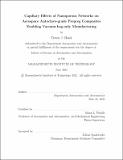Capillary Effects of Nanoporous Networks on Aerospace Autoclave-grade Prepreg Composites Enabling Vacuum-bag-only Manufacturing
Author(s)
Hank, Travis J.
DownloadThesis PDF (7.920Mb)
Advisor
Wardle, Brian L.
Terms of use
Metadata
Show full item recordAbstract
The use of carbon fiber reinforced polymer (CFRP) composite systems has grown in the aerospace industry due to their high mass-specific stiffness and strength and other properties. Yet, many advanced aerospace-grade CFRPs require autoclave pressure vessels to thermally process composites, which has numerous drawbacks such as high capital costs, hours-long heating and cooling cycles, high energy use, and bottlenecks due to fixed size. This work investigates various nanomaterial systems with nanoscale porosity, termed nanoporous network (NPN) materials, which are applied to each ply-ply interface in the composite prepreg laminates to remove voids by encouraging resin infusion through capillary effects. This removes the need for applied autoclave pressure and enables vacuum-bag-only (VBO) curing of autoclave-grade composites using either conductive or convective heating under vacuum. Aligned carbon nanotubes (A-CNTs) have been successfully utilized as textured NPNs with aligned capillaries, but alternative, particularly scaled and lower-cost, NPN materials are of interest. Commercially-available electrospun polymer nanofiber (EPN) films with different fiber diameters, film thickness, and polymer material are investigated extensively and a bespoke-commercial polyimide (PI) aerogel is preliminarily investigated. EPN NPN interlayers are able to create void-free laminates as revealed by micro-computed tomography (µCT) on flat aerospace-grade CFRP laminates using unidirectional epoxy-based prepreg plies. The VBO cured EPN NPN laminates are also found to have the same interlaminer shear strength as the autoclave-cured baseline laminates. It is found that polymer (polyimide) aerogels with a given porosity of 96 vol% are also a viable NPN. L-shape geometries with autoclave-grade laminates are preliminary examined with the investigation revealing void elimination, including in the problematic curved section using EPN NPN interlayers when cured under VBO conditions. Investigations using interlaminar NPNs to reduce voids in laminates that contain woven-woven and unidirectional-woven prepreg interfaces reveal significant void reductions, but not elimination, utilizing various NPNs, such that continuing challenges exist for full void elimination. Future work includes parametric studies of various NPN materials to further increase the breadth of NPNs available as well as quantifying the precise capillary pressures needed in different prepreg systems to eliminate interlaminar voids.
Date issued
2021-06Department
Massachusetts Institute of Technology. Department of Aeronautics and AstronauticsPublisher
Massachusetts Institute of Technology